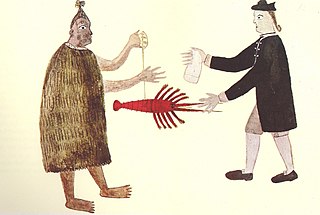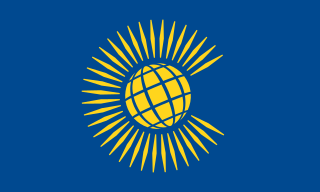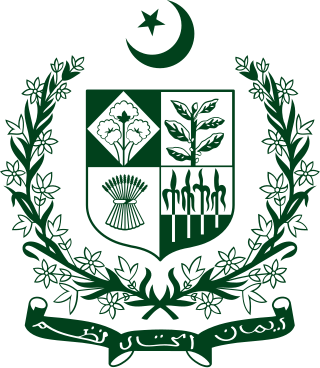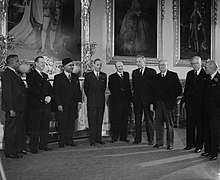
The Statute of Westminster 1931 is an act of the Parliament of the United Kingdom that sets the basis for the relationship between the Commonwealth realms and the Crown.

Governor-general, or governor general, is the title of an office-holder. In the context of governors-general and former British colonies, governors-general are appointed as viceroy to represent the monarch of a personal union in any sovereign state over which the monarch does not normally reign in person. Governors-general have also previously been appointed in respect of major colonial states or other territories held by either a monarchy or republic, such as Japan in Korea and France in Indochina.

A Commonwealth realm is a sovereign state that has Charles III as its monarch and head of state. All the realms are equal with and independent of the others, though one person, resident in the United Kingdom, acts as monarch of each. The phrase Commonwealth realm is an informal description not used in any law.

The National Party, also known as the Nationalist Party, was a political party in South Africa from 1914 to 1997, which was responsible for the implementation of apartheid rule. The party was an Afrikaner ethnic nationalist party, which initially promoted the interests of Afrikaners but later became a stalwart promoter and enactor of white supremacy, for which it is best known. It first became the governing party of the country in 1924. It merged with its rival, the SAP, during the Great Depression, and a splinter faction became the official opposition during World War II and returned to power. With the National Party governing South Africa from 4 June 1948 until 9 May 1994, the country for the bulk of this time was only a de jure or partial democracy, as from 1958 onwards non-white people were barred from voting. In 1990, it began to style itself as simply a South African civic nationalist party, and after the fall of apartheid in 1994, attempted to become a moderate conservative one. The party's reputation was damaged irreparably by perpetrating apartheid, and it rebranded itself as the New National Party in 1997 before eventually dissolving in 2005.

The Dominion of New Zealand was the historical successor to the Colony of New Zealand. It was a constitutional monarchy with a high level of self-government within the British Empire.

The Head of the Commonwealth is the ceremonial leader who symbolises "the free association of independent member nations" of the Commonwealth of Nations, an intergovernmental organisation that currently comprises 56 sovereign states. There is no set term of office or term limit and the role itself has no constitutional relevance to any of the member states within the Commonwealth. The position is currently held by King Charles III.

From 1910 to 1961 the Union of South Africa was a self-governing country that shared a monarch with the United Kingdom and other Dominions of the British Empire. The monarch's constitutional roles were mostly delegated to the Governor-General of the Union of South Africa.
The state known today as Ireland is the successor state to the Irish Free State, which existed from December 1922 to December 1937. At its foundation, the Irish Free State was, in accordance with its constitution and the terms of the Anglo-Irish Treaty, governed as a constitutional monarchy, in personal union with the monarchy of the United Kingdom and other members of what was then called the British Commonwealth. The monarch as head of state was represented in the Irish Free State by his Governor-General, who performed most of the monarch's duties based on the advice of elected Irish officials.

The criteria for membership in the Commonwealth of Nations, which apply to current and prospective member states, have been altered by a series of documents issued over the past eighty-two years.

The independence of New Zealand is a matter of continued academic and social debate. New Zealand has no fixed date of independence from the United Kingdom; instead, political independence came about as a result of New Zealand's evolving constitutional status. The concept of a national "Independence Day" does not exist in New Zealand.

The republics in the Commonwealth of Nations are the sovereign states in the organisation with a republican form of government. As of June 2022, 36 out of the 56 member states were republics. While Charles III is the titular Head of the Commonwealth, the King is not the head of state of the republican members. The King is however, the reigning monarch in the Commonwealth realms. The Head of the Commonwealth role does not carry with it any power; instead, it is a symbol of the free association of Commonwealth members.

The London Declaration was a declaration issued by the 1949 Commonwealth Prime Ministers' Conference on the issue of India's continued membership of the Commonwealth of Nations, an association of independent states formerly part of the British Empire, after India's transition to a republican constitution.
In the Commonwealth of Nations, a high commissioner is the senior diplomat, generally ranking as an ambassador, in charge of the diplomatic mission of one Commonwealth government to another. Instead of an embassy, the diplomatic mission is generally called a high commission.

The Commonwealth of Nations is a voluntary association of 56 sovereign states. Most of them were British colonies or dependencies of those colonies.
Australia is a constitutional monarchy whose Sovereign also serves as Monarch of the United Kingdom, New Zealand, Canada and eleven other former dependencies of the United Kingdom including Papua New Guinea, which was formerly a dependency of Australia. These countries operate as independent nations, and are known as Commonwealth realms. The history of the Australian monarchy has involved a shifting relationship with both the monarch and also the British government.

The Commonwealth of Nations, often simply referred to as the Commonwealth, is an international association of 56 member states, the vast majority of which are former territories of the British Empire from which it developed. The chief institutions of the organisation are the Commonwealth Secretariat, which focuses on intergovernmental aspects, and the Commonwealth Foundation, which focuses on non-governmental relations among member states. Numerous organisations are associated with and operate within the Commonwealth.
A dominion was any of several self-governing countries of the British Empire. With the evolution of the British Empire into the Commonwealth of Nations, the dominions became independent states, either as commonwealth republics or commonwealth realms.
External association was a hypothetical relationship between Ireland and the Commonwealth of Nations proposed by Éamon de Valera in 1921–22, whereby Ireland would be a sovereign state associated with, but not a member of, the Commonwealth; the British monarch would be head of the association, but not head of state of Ireland. De Valera proposed external association as a compromise between isolationist Irish republicanism on the one hand and Dominion status on the other. Whereas a full republic could not be a member of the Commonwealth until the London Declaration of 1949, a Dominion could not be fully independent until the Statute of Westminster 1931.

From 1947 to 1956, the Dominion of Pakistan was a self-governing country within the Commonwealth of Nations that shared a monarch with the United Kingdom and the other Dominions of the Commonwealth. The monarch's constitutional roles in Pakistan were mostly delegated to a vice-regal representative, the governor-general of Pakistan.

The 1948 Commonwealth Prime Ministers' Conference was the third Meeting of the Heads of Government of the British Commonwealth. It was held in the United Kingdom in October 1948, and was hosted by that country's Prime Minister, Clement Attlee.















